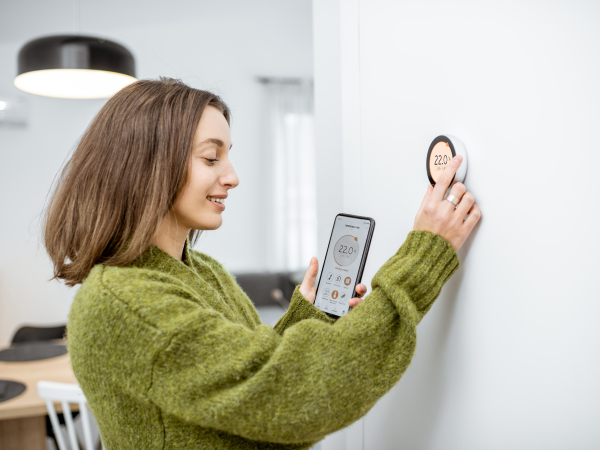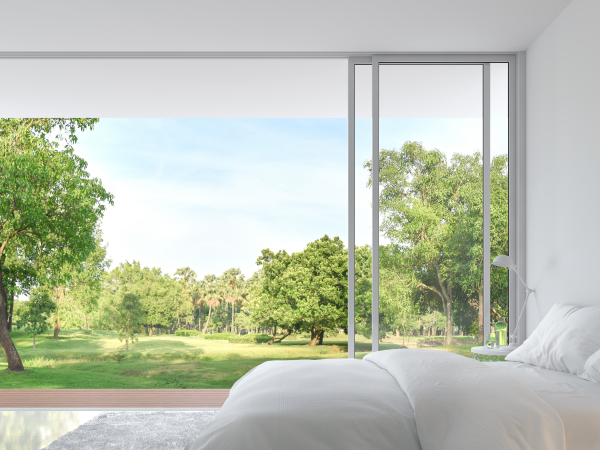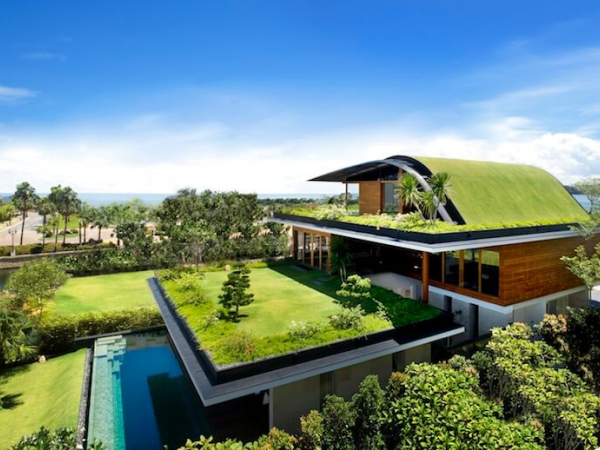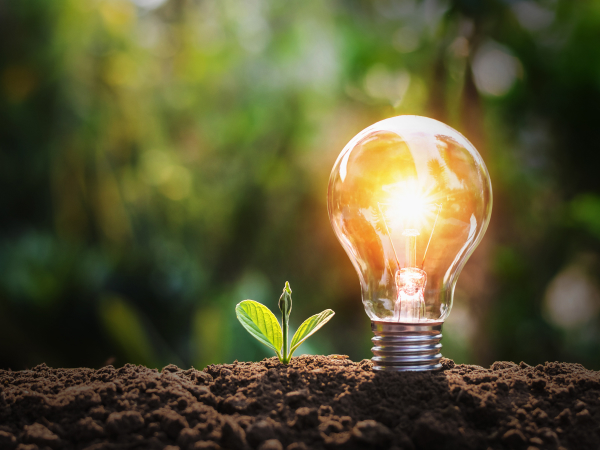
Make your home more sustainable
Homeowners all over the world are becoming more aware of the environmental issues affecting the planet.
So much so that sustainable living has become a key element in new residential projects and home renovations.
While purchasing a new house with cutting-edge eco-friendly materials might be costly, there are many cost-effective methods you could apply to make your home greener.
This guide will provide you with helpful solutions on how to make your home more sustainable.

Here’s what this guide covers:
- Eco-friendly ways to control the temperature in your home
- Installing solar power in your home
- Sustainable home design ideas
- Invest in solar power if you work from home
- Inexpensive upgrades for a sustainable home
Eco-friendly ways to control the temperature in your home
Controlling the temperature of your home will maintain it at a pleasant, consistent, and regulated climate for the entire family to enjoy.While a thermostat or air conditioning is typically used to adjust home temperature, there are other excellent hacks to keep your home cooled or warm when you need it the most.
These are just a few of the numerous simple methods to make your house more energy-efficient and environmentally friendly to help you get through the coldest or warmest months of the year.
How to use less heat when it's cold
- Get a programmable thermostat
- Use insulated curtains
- Throw some soft area rugs on the tiles
- Get a hot water bottle
- Keep unused rooms closed
How to cool your house down the most eco-friendly way
- Install ceiling fans
- Keep windows closed during the day
- Place ice or cool water in front of a fan
- Upgrade your light bulbs
- Make use of cooling beddings
There are several different types of cooling mattresses available to keep you sweat-free during warm temperatures, such as moisture-wicking coverings and permeable foam cores. Adding cooling blankets and pillows will help you sleep better.
Cotton sheets are also a less expensive option. Cotton is more breathable than other fabrics thus it will keep you cool at night.
When and how to heat your home
Q: Is it cheaper to keep your house at constant temperature?Setting your thermostat to a constant temperature is an inefficient method to operate your heating, ventilation, and air conditioning system.
Because heat is transported from a high concentration zone to a low concentration region, the energy required to keep the temperature at the hotter part constant includes the energy leaked to the opposite end. The greater the temperature differential between the two locations, the faster heat is lost to the surroundings.
In other words, the higher the temperature inside your home relative to the outside, the faster energy escapes. Maintaining this energy leakage can significantly increase your electricity bills making it expensive to keep your house at a constant temperature.
The easiest way to remember to change your thermostat to a more efficient setting is to do so when you leave for work and then change it back when you come home. This 8-hour routine is an effective method for reducing energy leakage. Small adjustments like this can cut your power cost by 15%.
Smart thermostats, a high-tech trend in home heating, allow homeowners to regulate temperatures remotely and conserve energy.
Q: Is it better to heat one room or the whole house?
Heating a single room in a smaller home is generally not beneficial, since it is better to heat the entire house. In bigger homes, a single room may be worth heating separately. If your home has an open-plan layout, with your stairway, hall, or dining room integrated with your living room, heating only one area will be inefficient.
Because not all heating systems are created equal, the method you use to heat your home has the most influence. While wood-fired and gas-fired heating may appear to be less expensive, using an electric heater remains simple and efficient when there is no loadshedding. However, electrical heaters are not energy-efficient. They use lots of energy and it's also very easy to end up overheating the room.
Q: What is the most environmentally friendly heater?
- Intelligent thermostats
The Nest Learning Thermostat learns and adjusts itself to your comfort level using smart learning technology. The thermostat also works in conjunction with the Nest smartphone app, allowing you to remotely alter the temperature so that your house is warm when you get home, or to set the temperature down to conserve energy while you're gone. The Nest thermostat will also notify you if something is wrong with your systems such as if the temperatures are so low that your pipes may break.
- Floor insulation
KlimaBoard is a lightweight, reinforced polystyrene floor insulation board. They are frequently installed beneath electric floor heating systems to decrease downward heat loss into the concrete slab, therefore increasing warming times and lowering energy usage.
- Infrared heaters
Voltex, a leading electrical solutions provider in South Africa, offers a broad selection of infrared heaters that not only keep you warm in the winter but are also energy efficient and allow you to bask in the sunlight like rays. These heaters quickly warm all required objects and surfaces in a space, making the most of the heat provided. They do not cause unpleasant air recirculation and, most importantly, do not emit carbon monoxide or burn oxygen, making the heated atmosphere healthier.
Controlling the temperature in your home is an effective way to save money and energy. Finding the ideal solution to meet your heating and cooling requirements can assist you in achieving your goals of making your home more environmentally friendly.

Installing solar power in your home
Installing solar panels in your home is an appealing asset to potential buyers if you decide to sell your property. Many individuals are conscious of their carbon footprint and want to live a more eco-friendly lifestyle. Solar power is an environmentally friendly answer as it is the conversion of solar energy into thermal or electrical energy. The sun supplies more than enough energy to fulfill the entire world's energy demands and, unlike fossil fuels, it will not run out anytime soon.
The primary limitation of solar power as a renewable energy source is the capacity to convert it into electricity in an efficient and cost-effective manner. And, while the installation can be costly, it can save you thousands of rands in the long run.
How does solar power work?
Solar power uses solar panels put on your home's roof to collect the sun's natural energy. Solar energy is transformed into electricity, which is used to power your entire home. These panels are made up of hundreds of cells made up of semi-conductive material layers (normally silicon). When the solar panels receive sunlight, the cells generate an electrical current.When exposed to direct sunlight, each solar panel may provide between 200 and 350 watts of power.
Types of solar panels for your home
Solar panels vary in terms of appearance, performance, and cost. Here are three main types you can use in your home:
The correct solar panel is determined by the task and cost. While polycrystalline solar panels are more popular in residential buildings due to their lower cost, monocrystalline panels still have a role.
How much solar power do you need?
The average family utilises six to fourteen 455W solar panels, with larger homes requiring up to 23 panels. Your solar power requirements will be determined by the amount of accessible space, your electricity use, and the specifications of your inverter.Your individual requirements must also be considered. Do you need backup power? Or do you wish to go fully off the grid?
What is the cost of solar power?
Full solar energy installations may be expensive. It can range from R80 000 for simple grid-tied systems to over R500 000 for entirely off-griding a bigger property. A house of 80 square metres, for example, would use 2 kW of power each day, and this system would cost around R63 000. A larger 5 kW system would be recommended for a 250 square metre home, costing around R110 000.Are there any regulations regarding solar power in South Africa?
Currently, there is no blanket regulation standard that covers the entirety of photovoltaic installations. However, as a precaution, homeowners should ensure their solar installations comply with standard electrical regulations.Some of the technical regulations relating to solar installations include:
- Installers must ensure that the roof structure can support the solar system.
- Where it is impossible to comply, a professional engineer or registered technologist must design the installation to incorporate the standard’s safety and performance principles.
- Water heaters or storage tanks with a capacity of 200 litres or more may not be attached to a wall.
- The solar system must be installed so that it does not accelerate the deterioration of the roof.
Sustainable home design ideas
Building sustainable homes is a priority for the greatest architectural companies and homeowners who can afford the high expenses associated with it. While some homeowners choose simplicity, others can go above and beyond the greenest of dreams.

When considering a new interior design, lighting is an important factor in making a building more sustainable. As bi-fold doors and huge picture windows become more common in houses, it is critical to consider energy efficiency while installing them. All windows are energy rated, with A++ being the highest.
The sun is the best source of low-cost, clean energy. Make use of the topography and light levels within your land in the most effective way if you are building a home from the ground up. The position of your house on your property will have a big impact on how often you can utilise your solar panels and how much power you can gather.
Modern homes preserve nature's beauty by planning and building around it. Tall, strong trees, the smooth and rustic texture of their bark, bank slopes, and the unparalleled vistas they provide inspire many building ideas.

Homes with green roofs mix in nicely with their natural environment. Turf is a common building material in regions such as Iceland due to a lack of trees, and strong turf walls were beneficial to fend off the cold.
In tropical climates such as Singapore, green roof houses can assist to minimise overheating. Grass absorbs far less heat than typical roofing materials, resulting in less thermal storage in the structure itself. This minimises the need for cooling systems.
An energy-efficient designed green roof may allow you to grow plants and herbs, as well as collect and filter rainwater for your kitchen and bathrooms, all while insulating your home.
Reasons to invest in solar power if you work from home
Working from home will undoubtedly result in an increase in the cost of your electricity bills. As you begin to consume more power around the house, now might be an excellent time to invest in a solar system for your home.

- Solar power saves you money
The amount of money you may save on your energy costs is one of the most significant benefits of solar energy. By converting sunlight to solar power in your home, you use less power from the grid and save money on traditional electricity techniques. You'd want your power expenses to be as low as possible when working from home. You will begin saving money the day your solar system is installed.
- Making the most of the natural daylight
Working from home with solar power is perfect if you want to maximise your investment. Because the majority of your energy consumption changes to daytime hours, you'll use less energy at night, when you'd typically buy from the grid. Working from home helps you to complete more high-energy chores throughout the day. This can include loading the dishwasher or starting the washing machine, both of which can save you money over time.
- Increase in your property value
Finally, think about how your solar panel investment will affect the value of your home. Buyers are becoming more interested in eco-friendly houses, and the extra efficiency of a pre-installed solar panel system is a plus. This sort of renewable energy investment may increase property values, especially if you install visually attractive solar panels that fit in with the slates on your roof.
Inexpensive upgrades for a sustainable home
Sustainable homes have a lower environmental effect while still providing daily necessities. One of the most common misunderstandings about the sustainable house movement is that it is just for the wealthy. However, with the right inexpensive upgrades, your home can be sustainable too.
These tips will assist you in moving your home toward sustainability while keeping you out of debt.
- LED bulbs
LED lighting is a popular sustainable design trend since it is both attractive and environmentally beneficial. When compared to incandescent bulbs and compact fluorescent lights, using light bulbs with LED technology can reduce your energy bills while making your home both eco-friendly and stylish. What’s more, LED bulbs have a long life span and low heat radiation.
Take this, for example, a 6-to-8-watt LED bulb with an 800 lumen light output will last 50 000 hours. Incandescent bulbs last 1 200 hours and use 60 watts, meanwhile CFL bulbs last 8,000 hours and require 13-15 watts.
LED bulbs are less harmful to the environment in both their manufacturing and usage than incandescent bulbs and compact fluorescent lights. LED lights require less energy per unit (lumen) of light output, which helps power plants minimise greenhouse gas emissions. LEDs produce very little carbon dioxide. One LED bulb, on average, reduces greenhouse gas emissions by nearly half a ton. An LED bulb's annual energy usage is around 30 times lower than that of a comparable incandescent bulb.

- Organic fertilisers
Purchasing fertilisers on a regular basis to promote the health of your plants might be pricey. More importantly, the chemicals contained in them can be dangerous since they may include compounds that are harmful to the skin or respiratory system. The good news is that you can compost your food leftovers and yard waste to create organic fertilisers. Compost is 100% natural, affordable, and may significantly improve soil structure.
Some typical misunderstandings about home composting include that it is too difficult, smells bad, and is messy. These statements may be true if you compost incorrectly, however composting properly is actually extremely simple. Simply stack organic items, add a slight amount of soil, and a sprinkle of water, and wait for your mixture to transform into humus.
You may then use this compost to enrich your flower garden, fertilise your grass, feed your growing vegetables, and more.
- Home insulation
Did you know that heating and cooling consume up to 44% of the energy utilised in your home? You may save a lot of energy and up to 10–50% on your power bill by using insulation in your house. Insulation will make it simpler to maintain a steady and pleasant temperature in your home, as well as lessen the load on your heaters and air conditioners, extending their longevity.
Insulation works by preventing air from naturally moving from warm areas to cool areas. This implies that insulation stops warm air from entering your home via the ceilings or walls during the summer months. In the winter, insulation keeps the cold out and the warm air in. In a nutshell, insulation keeps your home's core temperature stable so you don't have to turn down the air conditioner in the summer or turn up the heat in the winter.
An energy audit might help you figure out where energy is being wasted in your house. This entails inspecting your heating or air conditioning system, windows, doors, and other areas of your home to detect where energy is being lost. You may do a simple walk-through on your own or hire a professional to conduct a more comprehensive audit.







